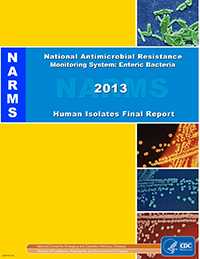The 2013 NARMS Human Isolates Report
CDC NARMS tracks antimicrobial resistance in Salmonella and other enteric (intestinal) bacteria that may cause mild or severe diarrhea or bloodstream infection. NARMS is an interagency partnership among the US Centers for Disease Control and Prevention (CDC), the US Food and Drug Administration (FDA), the US Department of Agriculture (USDA), and state and local health departments.

Bacterial foodborne infections are common and can be serious. In severe cases, the right antibiotic, also called antimicrobial agent, can be life-saving. NARMS is the only source of national information on antibiotic resistance in foodborne pathogens like Salmonella. Understanding trends in antibiotic resistance helps doctors to prescribe effective treatment and public health officials to investigate outbreaks faster.
The 2013 NARMS Annual Human Isolates Report [PDF – 81 pages, 9.78 MB] provides the most recent nationwide data on antibiotic resistance among:
- Salmonella
- Shigella
- Campylobacter
- E. coli O157
- Vibrio species other than Vibrio cholerae
Key Trends in 2013
To determine trends, NARMS compared the prevalence of resistance in 2013 with the average prevalence from two reference periods: 2004–2008 and the previous five years, 2008–2012. The 2004–2008 reference period begins with the second year that all 50 states participated in Salmonella and Shigella surveillance and all 10 FoodNet sites participated in NARMS Campylobacter surveillance. The additional 2008–2012 reference period allows comparison with more recent years. Some overall trends moved in the right direction; others were worth concern; still others were disturbing.
Right Direction
- Multidrug resistance in Salmonella was similar to last year and has remained stable over the past ten years
- 2013: 10%
- 2004-2008: 11%
- Resistance to two important groups of drugs remained rare, but notable
- 2013: ceftriaxone at 3% and quinolones at 3%
- 2004-2008: ceftriaxone at 3% and quinolones at 2%
- Resistance to an important drug pattern (ACSSuT) in Salmonella Typhimurium was lower in 2013 compared to both baseline periods (2004-2008 and 2008-2012)
Worth Concern
- There has been little change in Campylobacter resistance to fluoroquinolones, at times leaving macrolides as the sole treatment option
- Ciprofloxacin resistance in Campylobacter jejuni, the most common species isolated from humans, remains high at 22%
- Macrolide resistance in Campylobacter coli doubled from 9% in 2012 to 18% in 2013
-
Salmonella Enteritidis – the most common Salmonella serotype – accounted for 36% of infections resistant to nalidixic acid (the quinolone drug which is used in laboratory testing for resistance)
- Resistance to nalidixic acid relates to decreased susceptibility to ciprofloxacin, a widely used fluoroquinolone drug
- Other work shows that many of the nalidixic acid resistant Salmonella Enteritidis infections are acquired during travel abroad
-
Salmonella serotypes Dublin, Heidelberg, Newport, and Typhimurium accounted for over 2/3 of infections resistant to ceftriaxone
- 15% of serotype Heidelberg was resistant to ceftriaxone
Disturbing News
-
Salmonella Typhi (the bacteria that causes typhoid fever) resistance to a quinolone drug was higher in 2013 (67%) than in the baseline period of 2008-2012 (53%)
- Raising concerns that ciprofloxacin, a drug in the fluoroquinolone drug class and a common treatment for typhoid fever, may not be as effective
- Ciprofloxacin resistance was highest (9%) in 2013 compared to previous years
- Shigella resistance to ciprofloxacin increased to >3% in 2013 and azithromycin nonsusceptibility appears to be on the rise among Shigella flexneri
- Multidrug resistance in a common Salmonella serotype (l 4,[5],12:i:-) continues to rise
- Resistance more than doubled since 2011 (18% in 2011 vs. 46% in 2013) and has been linked to animal exposure and consumption of pork or beef, including meats purchased from live animal markets
Improved Reporting in 2015
NARMS will be making their data publically available. Check back for a link to the NARMS public tool, which will visualize and display NARMS data from 1996 to 2013.
Related Pages
- The World Health Organization’s categorization of antimicrobial agents of critical importance to human medicine (Appendix A, Table A1[PDF – 93 pages, 1.47 MB])
- Antibiotic / Antimicrobial Resistance
- Antibiotic Resistance Threats in the United States, 2013
- Federal antibiotic resistance budget initiative
- Interagency Task Force on Antimicrobial Resistance
- Detect and Protect Against Antibiotic Resistance: CDC’s Initiative to outsmart this threat
- Page last reviewed: June 15, 2015
- Page last updated: June 15, 2015
- Content source:



 ShareCompartir
ShareCompartir
